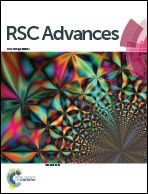Low temperature synthesis and characterization of substitutional Na-modified K2Ti6O13 nanobelts with improved photocatalytic activity under UV irradiation†
Abstract
The substitutional Na-modified K2Ti6O13 (NKTO) nanobelts were synthesized by a facile one-step method from NaCl–KCl melts at a relatively low temperature below 700 °C. The obtained samples were fully characterized by X-ray diffraction (XRD), energy dispersive spectrometer (EDS), scanning electron microscopy (SEM), transmission electron microscopy (TEM), high-resolution transmission electron microscopy (HRTEM), selected area electron diffraction (SAED), thermogravimetry and differential scanning calorimetry (TG-DSC), N2 adsorption–desorption analysis, UV-Vis diffuse reflectance spectroscopy and photoluminescence (PL) spectroscopy. The results revealed the highly crystalline NKTO nanobelts obtained above 680 °C exhibited not only a narrow distribution of particle size but good dispersivity. The replacement of K+ by Na+ ions reduced the interplanar spacing of K2Ti6O13 but did not destroy its oriented growth along [010]. From these results, the formation mechanism of the NKTO nanobelts was proposed. The specific surface area of the nanobelts showed a decrease with the increase of the synthetic temperature. Different titania phases were found to have a significant effect on the formation of NKTO nanobelts and rutile was the optimum titanium precursor. Substitutional Na-modification was demonstrated to not only red-shift the absorption edge and increase UV absorption but also to efficiently suppress the recombination of photogenerated electron–hole pairs. The photocatalytic tests showed the substitutional Na modification and lower synthetic temperature greatly promoted the activity for photodegradation of methyl orange under UV irradiation and the improved photocatalytic mechanism was also discussed.


 Please wait while we load your content...
Please wait while we load your content...